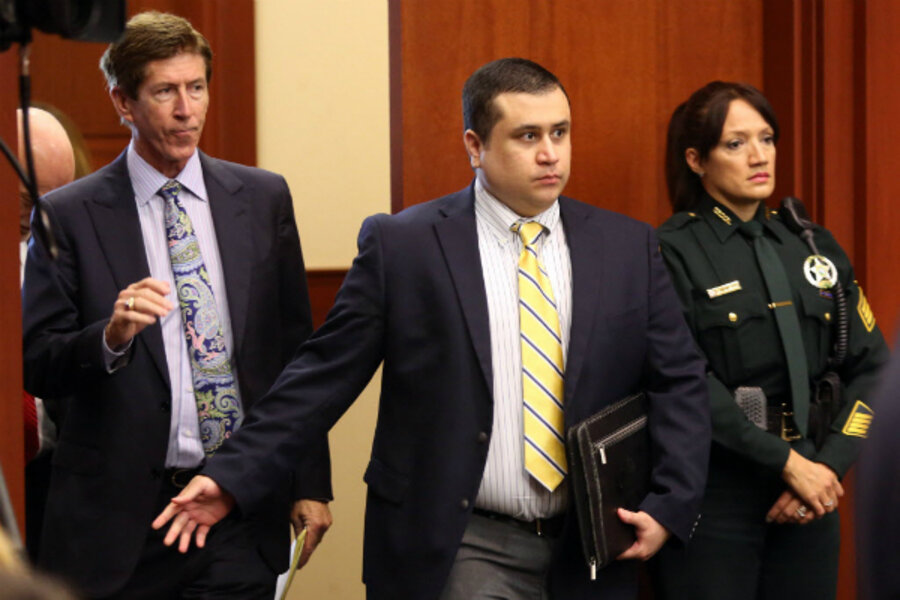Trayvon Martin texts, photos: Might they change Zimmerman trial?
Ultimately, many of the photos and cellphone records of Trayvon Martin released online Thursday by George Zimmerman’s defense attorneys – indicating that the slain teenager smoked marijuana, got into fights at school, and had an interest in, and perhaps access to, guns – may be ruled inadmissible in court. But they are already making the rounds in the court of public opinion, which can influence everything from fundraising efforts to the mind-set of potential jurors in Mr. Zimmerman's murder trial.
Mr. Zimmerman is slated to go on trial in June, accused of killing the 17-year-old Trayvon by shooting him at close range during a confrontation in a gated community in Sanford, Fla., in February 2012. Zimmerman claims he acted in self-defense. Trayvon’s family claims Trayvon was minding his own business after stopping at a store near the home he was visiting, and that Zimmerman confronted him without cause.
Zimmerman's defense team, however, on Thursday asked for a six-week delay in the trial. Circuit Judge Debra Nelson is expected to address that request at a pretrial hearing on Tuesday, as well as whether the photos and cellphone records will be admissible in court. She may also consider whether jurors can be told that the autopsy of Trayvon indicated that he had at least a small trace of marijuana in his system.
The judge might decide to wait to decide the admissibility of some of the evidence to see what approach the prosecution takes during the trial, says Eugene O’Donnell, a criminal justice professor at John Jay College in New York and a former prosecutor. “[Prosecutors] have to decide, will they depict [Trayvon] as a law-abiding teen … or not even go there…. The defense may argue that if the government raised the character of the victim, they will have the right of response,” he says.
The defense could also argue that the marijuana evidence is relevant because it could speak to the issue of whether Trayvon’s behavior seemed threatening to Zimmerman on the evening in question, but there is some precedent in Florida case law “that rejects the notion that marijuana makes you more aggressive,” Mr. O’Donnell says.
To the Martin family attorneys, the photos and cellphone records should be deemed irrelevant. “Is the defense trying to prove Trayvon deserved to be killed by George Zimmerman because [of] the way he looked?” they said in a statement Thursday. “If so, this stereotypical and closed-minded thinking is the same mindset that caused George Zimmerman to get out of his car and pursue Trayvon, an unarmed kid who he didn't know.”
Much of the evidence released Thursday is unlikely to ever go before a jury because it is irrelevant, says Bob Dekle, who teaches law at the University of Florida. “On a plea of self-defense you can sometimes get into evidence of prior violent acts or character of the deceased … but saying something about fistfights in high school? Kids get into fistfights at school. I did, and I don’t think that made me someone that needed to be shot,” he says.
Most evidence uncovered during “criminal discovery” in preparation for trial becomes a matter of public record in Florida, even if it isn’t allowed to be introduced to the jury. That’s an overly broad law, in Mr. Dekle’s opinion. “It offers a marvelous opportunity for gamesmanship on the part of both sides for disclosing stuff that they understand is not going to be admissible,” he says.
Calling attention to this material and playing it up in the press is a public-relations strategy, law experts say.
“No judge will allow this to be a trial of whether the victim is a bad person,” O’Donnell says, “but it can color the whole trial – it can color the judge’s view of the victim and can affect the jury pool.”
The photos and cellphone records will also likely stir up similar debates about racial stereotyping that first emerged with the question of whether Zimmerman was suspicious of Trayvon because he was black and wearing a hoodie.
One photo, for instance, depicts Trayvon showing some gold teeth – often considered a black stereotype. Another photo shows a handgun, and several show him sticking up his middle fingers. The cellphone texts could also be interpreted by some as heavy on street or even gangster-type language, and for some potential jurors, that would stick in their minds, O’Donnell says.
With the country polarized around this case, these depictions would try to bolster the anti-Trayvon sentiment and perhaps help raise money for Zimmerman’s defense, O’Donnell adds.
Associated Press material was used in this report.







